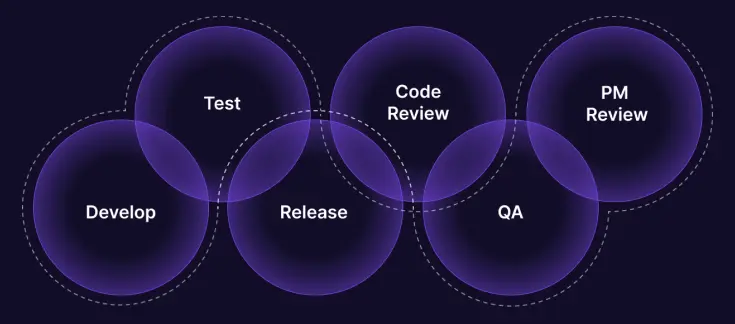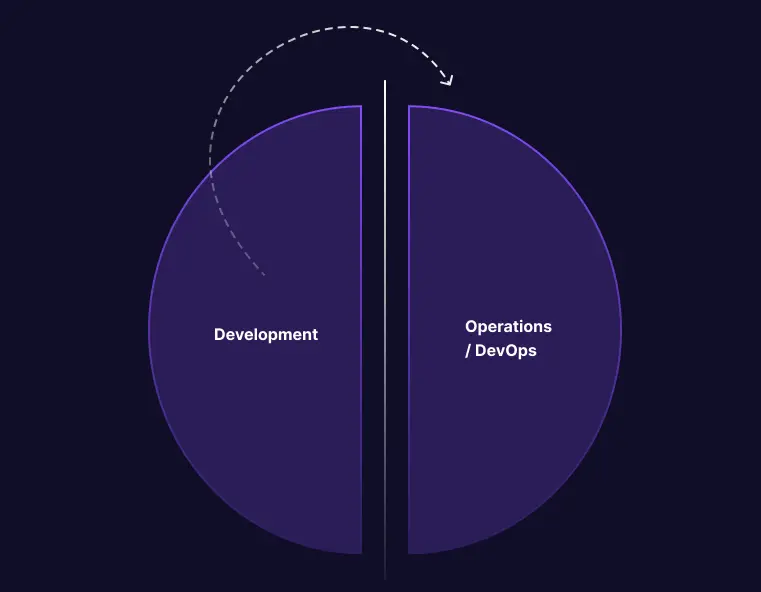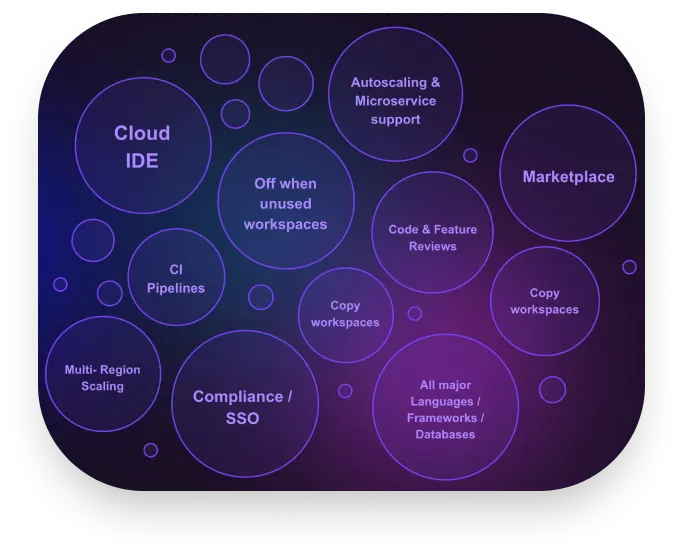Building software in a fast paced business environment
How enabling developers to manage their own applications landscape infrastructure improves time to market.

To understand the rationale behind Codesphere, consider a metaphorical journey to a mental vantage point. From this elevated perspective, let's examine the business world. We'll start with a fundamental question:
What drives the business world?
Four key elements are universally relevant across the market:
- Effectiveness: Every business aims to optimize its processes for better results. Continuous improvement of products and services is vital for competitiveness.
- Efficiency: Resource efficiency is crucial for economic success. Businesses strive to minimize costs while maximizing performance.
- Sustainability: Sustainability is an ecological and economic goal. Businesses increasingly adopt sustainable practices for long-term success, including resource conservation, waste reduction, and minimizing ecological footprints. Compliance with environmental and social responsibility laws also contributes to sustainability.
- Agility: In today's fast-paced world, agility is essential. Businesses must quickly adapt to market changes, recognize new trends, and rapidly implement innovations. Agility enables seizing opportunities, minimizing risks, and efficiently addressing customers.
These goals underpin the success and sustainable growth of businesses in a dynamic market environment. The very next question comes almost naturally:
What influences our business world?
The business world today is subject to a variety of influences, reflected in the VUCA attributes (Volatility, Uncertainty, Complexity, Ambiguity) and the concept of disruption, including "Black Swan" events.
- The VUCA Concept:
- Volatility: The nature and dynamics of changes, and the speed at which they occur.
- Uncertainty: The extent of unpredictability and the prospects for surprises.
- Complexity: The diversity and confusing factors that companies must consider.
- Ambiguity: The ambiguity of reality; the difficulty of distinguishing between cause and effect.
The VUCA concept, developed in the 1990s by the US Army War College, describes the geopolitical changes after the Cold War. With the collapse of the USSR, the US military had to face a new, more unclear threat situation. Today, many strategy consultants use VUCA to explain economic developments, but this concept alone is not sufficient, as there are other factors.
- Disruption and Black Swan Events:
Disruption and Black Swan events have become defining forces in today's rapidly evolving business landscape, compelling organizations to reevaluate their strategies and resilience in the face of unforeseen challenges.
- Disruption: Refers to radical changes that can make existing business models, products, or services obsolete.
- Black Swan Events: According to Nassim Nicholas Taleb, these are rare and unpredictable events with significant impacts. They are outliers, so they are outside the normal expectations, as nothing in the past convincingly indicates their possibility. They have an extreme impact and are often explained in hindsight as if they were predictable.
This combination of influences poses major challenges for companies: Volatility and uncertainty make long-term planning difficult, complexity increases the demands on management, and ambiguity leads to difficult decision-making processes. Disruptive technologies and market changes can lead to a rapid loss of market relevance, while Black Swan events, like the COVID-19 pandemic, the 2008 financial crisis, or the Ukraine war, can have sudden and profound impacts on global markets and individual companies.
Presently, Germany faces a budgeting crisis stemming from a ruling by the Federal Constitutional Court, which opposed the reallocation of funds from the COVID-19 relief fund to support climate protection measures. This decision has resulted in a 60-billion-euro deficit in the upcoming year's budget.
For businesses, it's crucial to develop strategies that allow for flexibility and adaptability in response to volatile, uncertain, complex, and ambiguous conditions. It's equally important to prepare for potential disruptions and Black Swan events by creating robust and resilient business models that can withstand unpredictable circumstances.
What does all this have to do with software and its development?
The challenges posed by the VUCA environment and Black Swan events are closely intertwined with software development. In a world where, as Marc Andreessen puts it, "software is eating the world," the ability to quickly adapt and respond via software becomes increasingly crucial.
- Relevance of Software in the VUCA World: In a volatile, uncertain, complex, and ambiguous environment, businesses need to be able to respond quickly to changes. Software plays a key role here, as it enables the automation of processes, makes them more efficient, and allows quick responses to market changes. It supports businesses in remaining flexible and adaptable.
- Agile Software Development: The trend towards agile development is a direct response to the VUCA challenges. Agile methods like Scrum or Kanban enable software teams to be more flexible and responsive. Instead of following rigid, long-term plans, agile methods allow for iterative, adaptable development that can respond quickly to changes in the business environment.

- Microservices and Modular Architecture: The move to microservices and other modular architectures like Composable Commerce and MACH (Microservices, API-first, Cloud-native, Headless) reflects the need for systems that are easily adaptable and expandable. Such architectures allow individual components of an application to be developed and scaled independently, increasing responsiveness to market changes.
- Significance of "Software Eats the World": The essay outlines why no industry can permanently protect itself from creative disruption by software- and technology-driven business models. Accordingly, software is the engine of rapidly growing, scalable, and robust business models. In a world where almost every company is also a software company, the ability to quickly develop and deploy software solutions becomes a crucial competitive advantage.
You may wonder whether this information is really new or simply a creative reassembly of already known knowledge. Well, possibly both are true. However, it is essential that you agree with this analysis, because what comes next is significantly less known:
Agile software development in non agile surroundings
Unfortunately many organizations have implemented agile software development processes without making sure other adjacent workflows are also following an agile approach. The following challenges arise when combining agile software development with classic software deployment processes:
- Deployment Expertise: Deployment requires specific expertise in technologies like Docker, Kubernetes, and Helm scripts. This expertise often sits in isolated teams or with specific people, following different workflows.
- Resource Scarcity and Costs: Experts in these technologies are rare and often expensive, leading to bottlenecks in the deployment process due to a lack of skilled personnel. Agile sprints are then dictated by surrounding factors outside the individual teams control, slowing them down.
- Provisioning Tools built for cloud providers not end users: Docker, Kubernetes, and Helm-Scripts often overprovision computing resources, benefiting cloud providers that charge per computer, leading to inefficient oversupply in development and test phases.
- Limited agility through rigid environment: While parts of the development process may be agile, since they are embedded in less agile delivery and provisioning workflows the ability to react to changing business needs is limited.

These factors lead to significant inefficiencies, reduced effectiveness, increased costs, and time expenditure. Additionally, the responsibility for these sub-processes is often segmented and optimized separately. Few managers have TCO (Total Cost of Ownership) responsibility, which can result in the described negative effects persisting over time. This unwanted "sustainability" needs addressing.
Why Codesphere?
The founders, familiar with the ups and downs of established software development processes, aim to creatively and robustly address these challenges. These are the questions to which they have found their answers:
- Why? We want to empower developers to manage their own infrastructure needs. Codesphere aims to increase the efficiency and effectiveness of software development processes and provide agile teams with the necessary tools to bring innovations to the market faster and more effectively.
- How? By developing unique solutions for software development, deployment, and operation that are both efficient and user-friendly. This is achieved by restoring the original procedural authority to the developer. We simplify software deployments to a point where no additional DevOps expertise is needed while maintaining flexibility.
- What? The Codesphere platform holistically supports the entire journey from code to cloud. Build from the ground up to enable developers to carry out the entire process as easy & efficient self-service.

This enables software teams to integrate agile deployment processes into their workflows, reduces cloud provisioning costs, and allows building better software faster. The culmination of these aspects offers greater sustainability than traditional methods. Recognizing this from a higher perspective, the initial question, "Why Codesphere?" can be answered:
Bridging the deployment divide leads to quicker and more cost-efficient software innovations.
